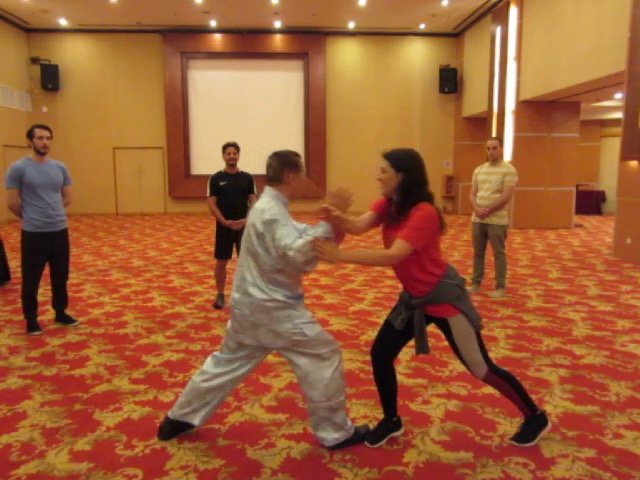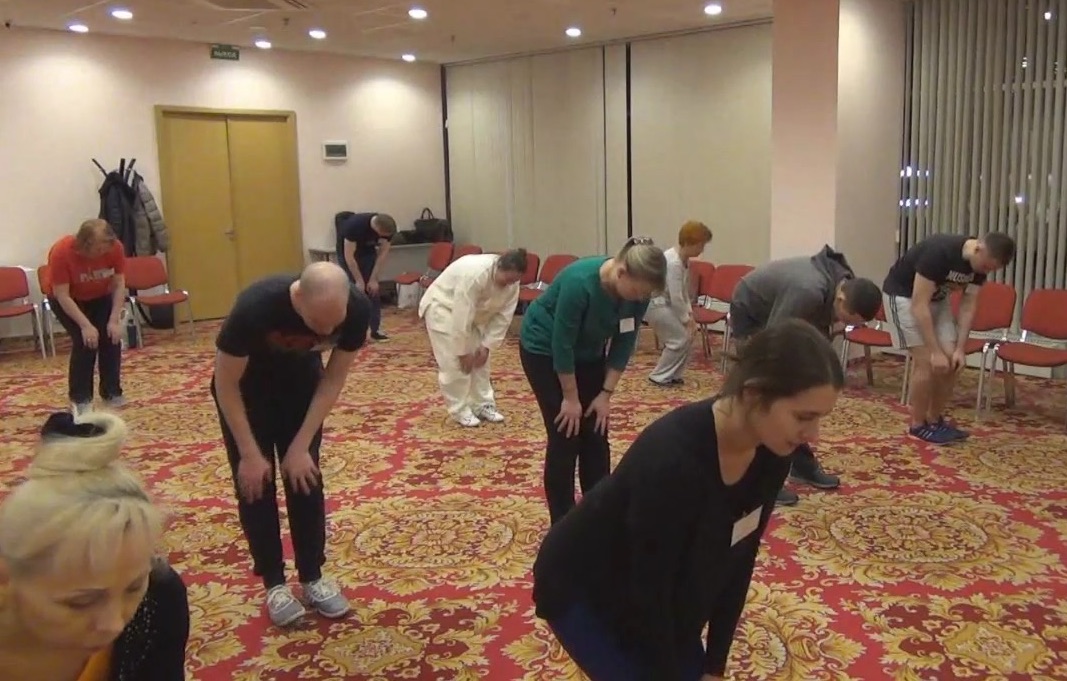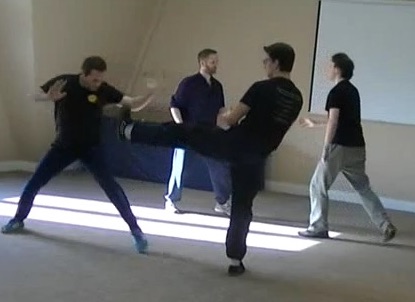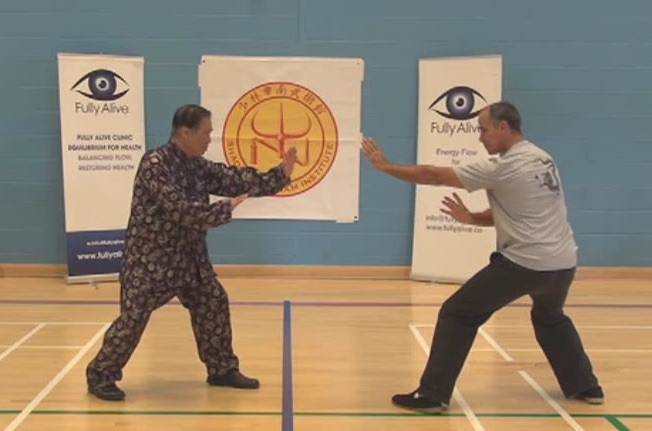SELECTION OF QUESTIONS AND ANSWERS
APRIL 2020 PART 3

Intensive Taijiquan Course in Penang in 2019
Question 1
Why do we practice Taijiquan if not for combat?
— Angel, Spain
Answer
It is an excellent question. Most people do not ask such questions though they dedicate much time and effort to their arts.
Today, most people do not practice genuine Taijiquan; they cannot use what they practice for combat, and they do not have internal force. They practice, what we call, Taiji dance. It is a sensitive statement, but it is the truth, and it is beneficial that our students know it.
Taijiquan is for combat; that is its first function. But today in our law abiding societies combat seldom happens. Then, why do we practice Taijiquan if not for combat?
For combat we need excellent health. There are other ways to have excellent health, like practicing chi kung. But a chi kung master would consider his job well done if his students have excellent health, whereas a Taijiquan master would start his students only when they have excellent health. One is the end of the training, whereas the other is the beginning.
Another reason is vitality. Chi kung also gives vitality, but the demand of Taijiquan is more. When a Taijiquan student is faced with a punch or kick, besides skills and techniques, he must have the vitality to avoid or counter it.
The third reason is responsibility. If an opponent punches or kicks a Taijiquan student, the student won't say why is the opponent faster than him, but he will learn to be as fast as his opponent or slow down the opponent using tactics. Taking responsibility is important in daily life.
Another reason is the learning of tactics and strategies which can be applied in non-combat daily life. One good tactic is to lead the opponent's attack to futility, place the opponent in a difficult position, then immediately hit the opponent -- like what we do in Taijiquan Pushing Hands. In non-combat daily life, when someone makes an accusation, instead of meeting the accusation head-on, you can lead the accusation to futility and immediately strike back. For example, when someone says you are late for work, instead of telling him that there is a traffic jam, you ask him whether he has been late for anything in his life, and what damage his lateness caused him.
It is very important to be relaxed in Taijiquan. The more relaxed a Taijiquan student is, the better he can perform in combat. Relaxation is even more important in non-combat daily life. Indeed, the three most widely suffered diseases deal with the ability to relax. But if you practice your Taijiquan every day, you don't even be sick at all.
Another reason for practicing Taijiquan is the development of internal force which contributes to combat. But in our non-combat daily life, the same internal force contributes to good health, vitality, longevity, peak performance and spiritual joys. In other words as a result of developing internal force when training genuine Taijiquan compared to the time when you did not train Taijiquan, you are now healthier, more vital, live longer, can perform better, and have more peace and happiness than before. Compare to other people who do not have the chance to train genuine Taijiquan, you have these wonderful benefits in your daily life.
These wonderful benefits occur if you train Taijiquan as a fighting art. If you train as Taiji dance, these wonderful benefits will not happen. Hence, even if we leave aside combat, it is worth to train genuine Taijiquan for daily life.
Question 2
Which is more useful, the Small Universe or the Big Universe?
Answer
While the Big Universe, or the Macro Cosmic Flow as it is called in some schools, is more advanced, I believe the Small Universe, or the Micro Cosmic Flow, is more useful. The Big Universe is for merging with the Cosmos where there is no differentiation. The Small Universe is for good health, vitality, longevity, peak performance and spiritual joys in our phenomenal world.
Great scholars and great kungfu masters aim for the Small Universe, as it gives them tremendous mental clarity and internal force. In the past, they would lock themselves in specially built chambers isolated from society in what is known in Chinese as "pi guan". When they had attained the Small Universe, they would come out of isolation and celebrate.
In our school, we have an additional benefit of attaining the Small Universe. Many people who attended my "Small and Big Universe" courses are very lucky. Actually when we practice genuine chi kung, not gentle physical exercise, we become lucky. The Chinese term for being lucky is "hou yun qi", which literally means "good circulation of energy". In the Small Universe, there is tremendous circulation of energy, which is a lot of "hou you qi".

A class practicing dynamic patterns in Russia
Question 3
After the Small and Big Universe Course, we have to practice the Small Universe or the Big Universe or both every day. Can we also practice dynamic patterns?
— Sifu Bernie Kissay, Malaysia
Answer
Yes, you can.
Our intensive courses concern learning. In other words, we learn a lot within a few days. But masters are made through practicing. In learning, we gather new material. In practicing we go over and over again material that we have learned.
After an intensive course, we must spend time to practice what we have learned. If we do not practice, we may gain some novelty, but not lasting benefits.
Hence, after the "Small and Big Universe Course", we need to practice the Small Universe or the Big Universe or both every day. I took about two and a half years to attain the Small Universe. This was very fast, because my sifu besides teaching me other things taught me Reverse Breathing. Other people who used Dan Tian Breathing would take about ten years.
A typical Shaolin Wahnam student would be ten times my rate of progress when I was a student -- a fact that many people might find it hard to believe. Hence, you would need about two to three months to practice the Small and Big Universe.
Practicing the Small and Big Universe will be your main training session. But of course you can also practice other things, including dynamic patterns, besides the Small and Big Universe.
Question 4
Thank you very much for writing and publishing "Sukhavati".
What would be a suitable time or number of recitations per meditation session? Some people say three honest recitations suffice. Others recommend reciting hundreds or thousands of times.
Is there a special connection between Amitabha Buddha and Shaolin Wahnam?
— Steffen, Germany
Answer
"Sukhavati" is a wonderful book. It has helped many people.
I like the part on the geography of the universe. The Buddha mentions there are islands surrounded by sea. In a flash of inspiration, I realize that what the Buddha means is that there are worlds surrounded by space. In his deep meditation, the Buddha sees reality in his mind's eyes.
A suitable time for recitation is in the morning. But any time can be appropriate.
As we may not have a one-pointed mind, it is recommended to recite "Namo Amitabha Buddha" in any language hundreds of times. As we recite our mind may become one-pointed. There is no fixed number for the hundreds of time.
The three deities depicted in Sukhavati, or the Pure Land, are Amitabha Buddha, Bodhisattva Avalokiteshvara, and Bodhisattva Mahasthamaprapta. Bodhisattva Avalokiteshvara, or Bodhisattva Guan Yin in Chinese, is the patron Bodhisattva of Shaolin Wahnam, hence the connection between Sukhavati and Shaolin Wahnam.

Combat application of Pakua Set
Question 5
How are you, Sigung?
— Miguel, Netherlands
Answer
Like all Shaolin Wahnam members, every day is treating me very well. At 75 I find joy and peacefulness every day, and I look towards everything with zest. Most importantly, I have good health, vitality and longevity.
Question 6
I have been practicing the Shaolin Travelling Pakua Set everyday as my specialty kung fu set. I had a very sudden, obvious and simple realisation about the set. This was of course the fact that Pakua stands for Bagua trigrams symbol. I also realised that the Pakua Set faces all these 8 cardinal directions. Am I correct about this assumption?
When in the set are you supposed to face southeast? If we take Sipak Goh Kok Hin's performance of the set, is it correct to face southeast during patterns 53-56 (Bar the Big Boss to Swimming Dragon Plays with Water)? After these patterns do we return to facing north again or northwest?
Answer
The Shaolin Traveling Dragon Pakua Set was the one that opened my combat enlightenment. You will appreciate it much.
Although the word "Bagua" stands for the Bagua trigram symbol, and the word "pakua" in Cantonese means the same as "bagua" in Mandarin, personally I don't find much religious significance in the set. It can be practiced and appreciated by anyone of any religion or the lack of it.
It is correct that the eight sequences of the Pakua set face all the eight cardinal directions. Referring to the webpage showing your sipak Goh Kok Hin performing the Pakua Set, if you start facing north, you will face southeast at patterns 53 to 57 ("Bar the Big Boss" to "Monkey Steals Peach"). In pattern 58, "Double Butterflies Flying", your feet are still in line with southeast, but you face the other direction, i.e. northwest. You continue facing northwest in this sequence, patterns 58 to 62, after which your line of direction is north until the end of the set.
You need not be too concerned with the compass directions. What is important is that the set gives you combat efficiency when needed, and good health and vitality as well as longevity at your old age.

Combat application of Wudang Kungfu
Question 7
Are you aware or have you read about number 72 and 13 techniques on the classics other than or prior to Zhang San Feng?
— Sifu Angel Perez, Puerto Rico
Answer
The number 72 was in existence prior to Zhang San Feng. It was in honour of the 18 Lohans. The patterns in Shaolin kungfu sets were usually linked to multiples of 18. Thus, in our school we have 36-pattern Tiger-Crane Set, 72-pattern Flower Set, and 108-pattern Triple-Stretch Set.
The 13 techniques refer to 4 main techniques, 4 secondary techniques and 5 types of movement. Zhang San Feng used these 13 techniques for his Wudang Taijiquan, which was called Wudang Shaolin Kungfu during his time, to differentiate the Henan Shaolin Kungfu at the northern Shaolin Monastery, and later the Fujian Shaolin Kungfu at the southern Shaolin Monasteries at Quanzhou and Jiulianshan. When Shaolin Kungfu spread to Guangdong after the burning of the southern Shaolin Monasteries, it was referred to as Guangdong Shaolin Kungfu.
The 4 main techniques are "peng", "lu", "qi" and "an", which correspond to "Immortal Waves Sleeves", "Double Dragons Play with Pearl", "Push Boat According to Flow" and "Open Window to Look at Moon" in our school.
The 4 secondary techniques are "cai", "lie" "zhou" and "kao", which I translate as "grip", "spread", "elbow", and "anchor", which correspond to "Old Eagle Catches Snake", "Cosmos First Emerges", "Cloud Dragon Shows Elbow" and "Black Bear Moves Shoulder" in the San Feng Wudang Set.
The term "techniques" is loosely translated. The term refers to "principles". For example, in "kao", any technique that uses the principle of "anchorage" is included. In the San Feng Wudang Set we have "Black Bear Moves Shoulder"; in Yang Style Taijiquan we have "Shoulder Strike". You can also refer to these 8 techniques and 5 movements as 8 symbols and 5 processes.
In 5 movements we have "jin", "tui", "gu", "pan" and "ding", which are moving forward, moving backward, moving to the left, moving to the right, and remaining at the centre. At first I was puzzled why "ding" or "remaining at the centre" was an important movement. Later I realized that it involved body-movement. For example, to neutralize a powerful punch, we do not move our feet but move our body backward.
I also wondered why "chen" or "sinking" was not included as a main movement. I later realized that past masters wanted to hide secrets in the open. For example, if an opponent wishes to fell you, using "chen" like "Black Bear Sinks Hips", you fell the opponent instead.
Question 8
I've read somewhere that there are 72 immortals in Taoism and it is also a multiple of 360 of a perfect circle or the heavens. Is it possible that 72 patterns of Wudang Kungfu could be related and/or based of these astronomical facts.
Is it possible that the thirteen techniques are linked to the lunar calendar of thirteen months and its influences on man? Zhang San Feng mentions the Eight Symbols and the Five Processes on the Treatise which link macro cosmic and micro cosmic events so there is an indication that the previous statements might have basis to be possible.
Answer
I don't know about 72 immortals in Taoism and that it is a multiple of 360 which is a cycle of heaven. I know of the Drunken 8 Immortals, and in preparation of the Drunken 8 Immortals course at the UK Summer Camp in 2011, I had an aha-experience. I discovered that if we knew the principle, we could overcome any pin-downs. It was heartening to see dainty ladies threw off hefty men who had pinned them down, yet overcoming pin-downs was weary of many masters.
I don't think Zhang San Feng related the "thirteen techniques" of Taijiqjuan to the lunar calendar of thirteen months. There are only twelve months in the lunar calendar, not thirteen, though sometimes there is a leap month.
Macro cosmic events and micro cosmic events influence each other. In traditional Chinese medical philosophy, the philosophy that has maintained the health of the biggest population of the world for the longest period of history, there are three causes of illness, namely external causes, internal causes, and neither external nor internal causes. An example each of these three causes are "heat" as an external cause, "worry" as an internal cause, and breaking one's bone as a result of a fall as a neither external nor internal cause. This shows how important is the link between macro and micro events.
LINKS
Selected Reading
- The Small Universe and Shaolin Cosmos Chi Kung
- Interesting Stories of Wong Fei Hoong
- Taijiquan Techniques against Knee Strikes
- You Have an Emorous Market
- Change from Worrying about How to Defend against your Opponent's Attack to Letting him Worry about How to Defend against your Attack
